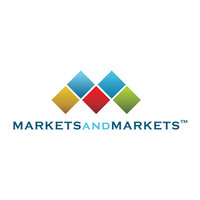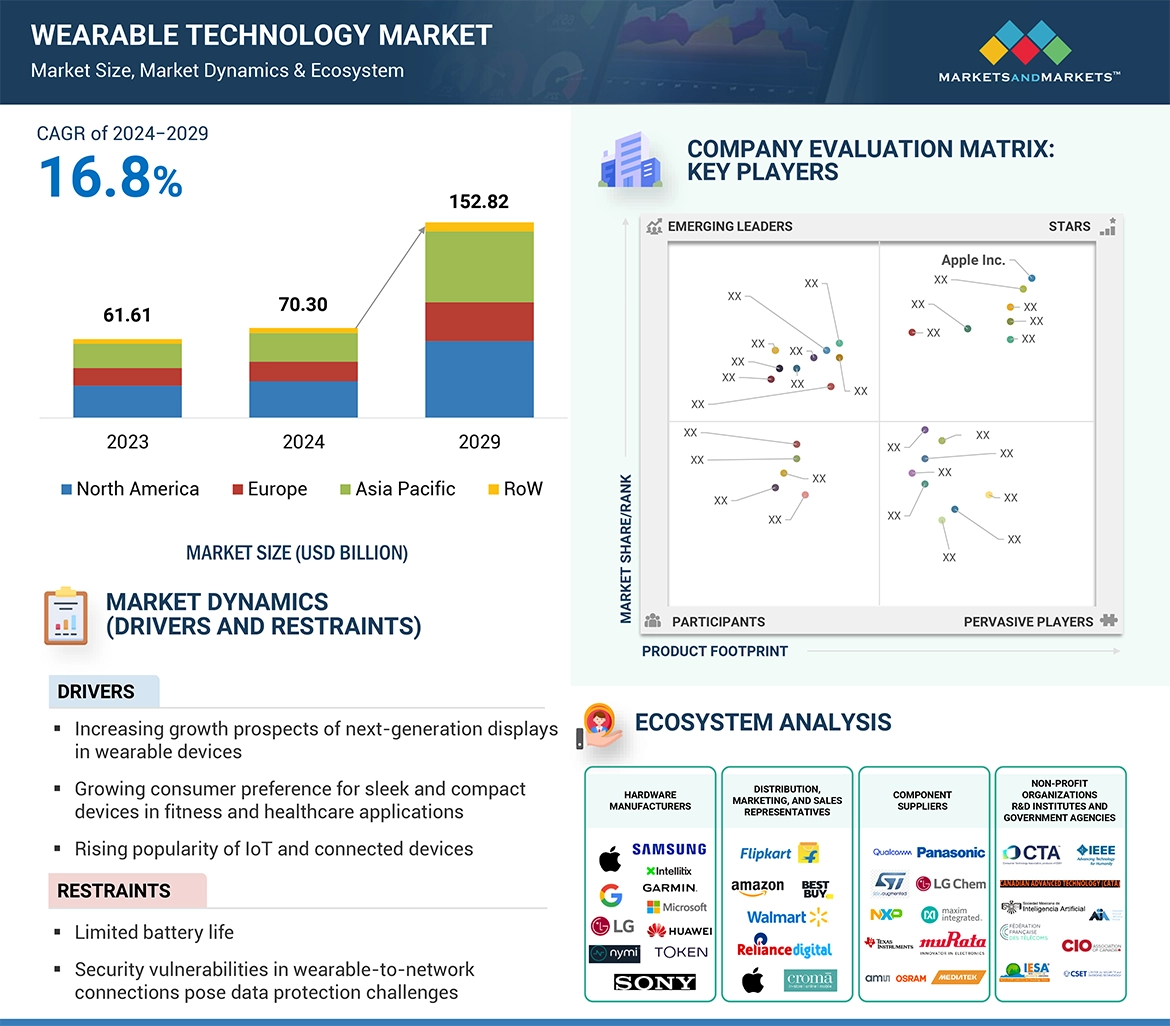The report “Wearable Technology Market by Product (Smart Watch, Fitness Tracker, AR/VR, Smart Clothing & Footwear, Earwear, Exoskeleton, Smart Glasses, Smart Ring, Smart Helmet), Operation (AI-Based, Conventional), Type (Active, Passive) – Global Forecast to 2029” The global wearable technology market is expected to be valued at USD 70.30 billion in 2024 and is projected to reach USD 152.82 billion by 2029; it is expected to grow at a CAGR of 16.8% from 2024 to 2029.
Demand for wearables that integrate all computing requirements in one compact device will fuel the market growth. Adoption of wearables in multiple applications. Data-driven performance optimization in sports through real-time monitoring of athlete metrics is pushing the adoption of wearable technology. Growing integration of AR/VR and affordable designs is providing opportunities for wearable technology market growth.
Download PDF Brochure @ https://www.marketsandmarkets.com/pdfdownloadNew.asp?id=983
Browse 210 market data Tables and 220 Figures spread through 315 Pages and in-depth TOC on “Wearable Technology Market”
View detailed Table of Content here – https://www.marketsandmarkets.com/Market-Reports/wearable-electronics-market-983.html
Consumer electronics application to hold the highest market share during the forecast period.
Consumer wearables include wearable devices for different applications, ranging from entertainment and multimedia to garments and fashion. The reason behind the growth of the market is accelerated by growing consumer interest in tracking fitness-related activities. Moreover, tremendous growth of low-cost consumer wearable devices, due to downsized multifunctional ICs and sensor technology, is driving its adoption. Because the sensors are small in size and have advanced integration technologies, they can be fitted in a variety of accessories such as wristbands, wristwatches, eyeglasses, clothing, caps, socks, shoes, headphones, and smartphones. For instance, in November 2023, British Roboticist Dr. Zeke Steer developed Smart Socks, which he had intended to aid patients who suffer from dementia. Symptoms of dementia include anxiety and aggression. The smart socks were tested successfully in UK care homes. These sensor-enabled socks were monitoring the movements of the body of the wearer, heart rate, and sweat of the person. Milbotix, a start-up founded by Steer, raised over USD 723k to take the product to global markets.
By Operation, AI-based segment is projected to grow at a high CAGR of wearable technology market during the forecast period.
AI-based wearable operations are likely to maintain the highest CAGR in the wearable technology market, because these technologies bringadvanced and revolutionary capabilities to offer personal experiences. Using AI, devices will not only enable the user for real-time insights into health, but also predictiveness, respond to the patient’s behavior patterns, biometric monitoring capabilities that become more accurate and sophisticated personal assistance, or automated health anomalies identification. Integration of AI into devices also increases the efficiency of the device, prolongs battery life, and enables natural language processing to make better user interactions. Moreover, the AI algorithms learn based on the data taken from users over a long period of time, thereby making devices progressively smarter, more personalized, and more penetrating in the marketplace that fuels strong growth within the market and among consumers.
Asia Pacific will account for the highest CAGR during the forecast period.
Wearable technology market in the Asia Pacific region continues to grow strongly with several factors. Higher smartphone penetration and greater internet access enable higher adoption of wearables. Health awareness and an ageing population drive up demand for fitness trackers and health-monitoring wearables. Further, miniaturization of devices and enhancements in battery life make it more user-friendly and appealing. The tech-friendly young population is adopting smartwatches and other wearables just as an accessory for fashion. The government focus on smart cities and digital health is also creating a supportive environment to permit growth in the market. A substantial percentage of manufacturing bases are present in countries like China and South Korea to produce cost-effective products and create innovative designs in wearable technology.
Key Players
Key companies operating in the wearable technology market Apple Inc. (US), Garmin Ltd. (US), SAMSUMG (South Korea), Sony Group Corporation (Japan), Huawei Technologies Co., Ltd. (China), LG Electronics. (South Korea), Alphabet Inc. (US), Microsoft (US), Lenovo (Hong Kong), Meta (US), Amazon.com, Inc (US), Xiaomi (China), OPPO (China), and Imagine Marketing Limited (India) among others.
Media Contact
Company Name: MarketsandMarkets™ Research Private Ltd.
Contact Person: Mr. Rohan Salgarkar
Email: Send Email
Phone: 18886006441
Address:1615 South Congress Ave. Suite 103, Delray Beach, FL 33445
City: Delray Beach
State: Florida
Country: United States
Website: https://www.marketsandmarkets.com/Market-Reports/wearable-electronics-market-983.html


